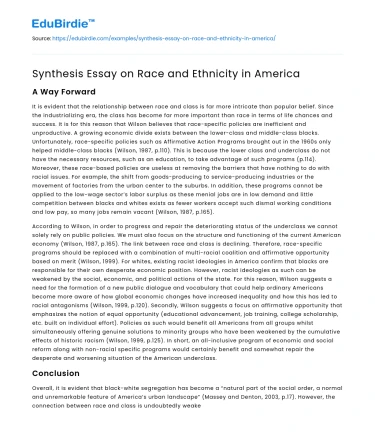A Way Forward
It is evident that the relationship between race and class is far more intricate than popular belief. Since the industrializing era, the class has become far more important than race in terms of life chances and success. It is for this reason that Wilson believes that race-specific policies are inefficient and unproductive. A growing economic divide exists between the lower-class and middle-class blacks. Unfortunately, race-specific policies such as Affirmative Action Programs brought out in the 1960s only helped middle-class blacks (Wilson, 1987, p.110). This is because the lower class and underclass do not have the necessary resources, such as an education, to take advantage of such programs (p.114). Moreover, these race-based policies are useless at removing the barriers that have nothing to do with racial issues. For example, the shift from goods-producing to service-producing industries or the movement of factories from the urban center to the suburbs. In addition, these programs cannot be applied to the low-wage sector’s labor surplus as these menial jobs are in low demand and little competition between blacks and whites exists as fewer workers accept such dismal working conditions and low pay, so many jobs remain vacant (Wilson, 1987, p.165).
According to Wilson, in order to progress and repair the deteriorating status of the underclass we cannot solely rely on public policies. We must also focus on the structure and functioning of the current American economy (Wilson, 1987, p.165). The link between race and class is declining. Therefore, race-specific programs should be replaced with a combination of multi-racial coalition and affirmative opportunity based on merit (Wilson, 1999). For whites, existing racist ideologies in America confirm that blacks are responsible for their own desperate economic position. However, racist ideologies as such can be weakened by the social, economic, and political actions of the state. For this reason, Wilson suggests a need for the formation of a new public dialogue and vocabulary that could help ordinary Americans become more aware of how global economic changes have increased inequality and how this has led to racial antagonisms (Wilson, 1999, p.120). Secondly, Wilson suggests a focus on affirmative opportunity that emphasizes the notion of equal opportunity (educational advancement, job training, college scholarship, etc. built on individual effort). Policies as such would benefit all Americans from all groups whilst simultaneously offering genuine solutions to minority groups who have been weakened by the cumulative effects of historic racism (Wilson, 1999, p.125). In short, an all-inclusive program of economic and social reform along with non-racial specific programs would certainly benefit and somewhat repair the desperate and worsening situation of the American underclass.
Conclusion
Overall, it is evident that black-white segregation has become a “natural part of the social order, a normal and unremarkable feature of America’s urban landscape” (Massey and Denton, 2003, p.17). However, the connection between race and class is undoubtedly weakening and class is becoming far more important than race. Wilson argues this point throughout much of his work. The American underclass is a growing problem that is simply not a cause of racial discrimination alone. According to Wilson, class is the crucial and determining factor of life success in America as the significance of race is dramatically declining. Wilson examines the development of race relations over three periods of American history, the pre-industrial era, the industrializing era, and the era of progressive transition from racial to class inequalities (Wilson, 1980). The significant decrease in the importance of race yet the striking rise in black long-term poverty and welfare dependency over these periods proves that the link between race and class is certainly diminishing. Wilson’s explanation for this is a number of structural forces and changes in the economy along with the role of the polity. Wilson rejects the race-specific Affirmative Action Programs and suggests that in order to repair the spreading underclass in American cities, a comprehensive program of social and economic reform is required, as well as non-racial specific programs (Wilson, 1999). In short, the relationship between race and class is now far less significant than it once was.






 Stuck on your essay?
Stuck on your essay?

